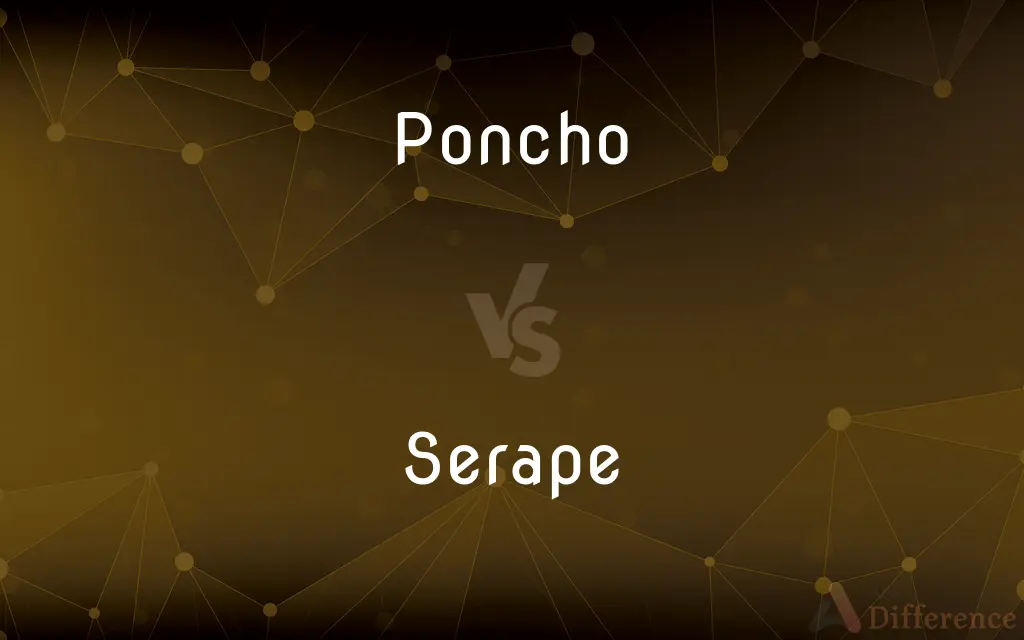Poncho vs. Serape — What's the Difference?
By Tayyaba Rehman — Updated on May 28, 2024
A poncho is a piece of outerwear with a central hole for the head, while a serape is a colorful, woven blanket or shawl, often worn draped over the shoulders.

Difference Between Poncho and Serape
Table of Contents
ADVERTISEMENT
Key Differences
A poncho is a traditional outer garment originating from South America, typically made from a single rectangular piece of cloth with a hole in the center for the head. It is designed to provide warmth and protection from the elements. A serape, on the other hand, is a colorful, blanket-like shawl or cloak that originates from Mexico. It is usually woven with vibrant patterns and can be worn over the shoulders or used as a blanket.
While both garments serve as outerwear and can provide warmth, the poncho is more utilitarian in design, focusing on function, whereas the serape is both functional and decorative, reflecting cultural artistry.
Ponchos are often used in modern fashion and outdoor activities due to their simplicity and versatility. Serapes, however, are frequently seen in traditional settings, cultural events, and as decorative items in homes, highlighting their cultural significance.
Comparison Chart
Primary Use
Outerwear for protection from rain or cold
Decorative shawl or blanket
Design
Single sheet with a hole for the head
Colorful, intricately patterned blanket
ADVERTISEMENT
Cultural Significance
Adapted worldwide
Traditionally Mexican
Materials
Varies, including rubber or waterproof fabrics
Traditionally woven, often from cotton or wool
Appearance
Can be plain or patterned
Known for vibrant stripes and patterns
Compare with Definitions
Poncho
A protective sheet, often waterproof.
Camping enthusiasts often carry a poncho for unexpected weather.
Serape
A vibrant, intricately patterned textile.
The serape on the wall added a touch of color to the room.
Poncho
A garment designed to keep the body warm.
She wore a woolen poncho during the chilly evening.
Serape
A representation of Mexican heritage and artistry.
The serape patterns tell stories of ancient traditions.
Poncho
A simple piece of attire without sleeves.
The poncho draped loosely over her shoulders.
Serape
A traditional Mexican blanket or shawl.
He wore a serape to the cultural festival.
Poncho
An outer layer with a central hole for the head.
His poncho kept him dry during the rainstorm.
Serape
A woven garment, often draped over the shoulders.
She wrapped a serape around her on the cold night.
Poncho
An adaptable piece of clothing used across cultures.
The poncho’s design has been modified in various countries.
Serape
A decorative piece used for attire or home décor.
The serape served as a cozy blanket on the couch.
Poncho
A poncho (Spanish pronunciation: [ˈpontʃo]; Quechua: punchu; Mapudungun: pontro; "blanket", "woolen fabric") is an outer garment designed to keep the body warm. A rain poncho is made from a watertight material designed to keep the body dry from the rain.
Serape
The sarape or jorongo is a long blanket-like shawl/cloak, often brightly colored and fringed at the ends, worn in Mexico, especially by men. The spelling of the word sarape (or infrequently, zarape) is the accepted form in Mexico and in other Spanish-speaking countries.
Poncho
A blanketlike cloak having a hole in the center for the head.
Serape
A long blanketlike shawl or poncho, often brightly colored, geometrically patterned, and fringed at the ends, worn especially in Mexico.
Poncho
A similar garment having a hood used as a raincoat.
Serape
Having the bright colors and geometric patterns of a serape
A serape cardigan.
Serape blankets.
Poncho
A simple garment, made from a rectangle of cloth, with a slit in the middle for the head.
Serape
A type of blanket worn as a cloak, especially by Spanish-Americans, or used as a saddle blanket.
Poncho
A similar waterproof garment, today typically of rubber with a hood.
Serape
A blanket or shawl worn as an outer garment by the Spanish Americans, as in Mexico.
Poncho
A kind of cloak worn by the Spanish Americans, having the form of a blanket, with a slit in the middle for the head to pass through. A kind of poncho made of rubber or painted cloth is used by the mounted troops in the United States service.
Serape
A long brightly colored shawl; worn mainly by Mexican men
Poncho
A trade name for camlets, or stout worsteds.
Poncho
A blanket-like cloak with a hole in the center for the head
Common Curiosities
Can a serape be used as a blanket?
Yes, serapes can be draped over the body or used as blankets.
Is a poncho exclusive to Latin America?
No, while it has Latin American origins, the poncho design has been adapted worldwide.
What is the primary function of a poncho?
A poncho is primarily used as protection from rain or cold.
What is the significance of the serape in Mexican culture?
The serape is a symbol of Mexican identity, representing tradition and artistry.
Is a serape the same as a poncho?
No, a serape is a colorful, woven blanket or shawl, while a poncho is a protective garment with a hole for the head.
Are all ponchos waterproof?
No, while some ponchos are made of waterproof materials, others are designed for warmth rather than rain protection.
Can you wear a serape in different styles?
Yes, a serape can be draped over the shoulders, worn as a shawl, or used as a blanket.
What makes serapes distinctive in appearance?
Serapes are known for their vibrant stripes and intricate patterns.
What materials are ponchos made of?
Ponchos can be made from various materials, including wool, cotton, and waterproof fabrics.
Do ponchos have sleeves?
Typically, ponchos are sleeveless, characterized by a single sheet with a hole for the head.
Are ponchos considered fashionable?
Yes, ponchos have been incorporated into fashion trends across the world.
What occasions are suitable for wearing a serape?
Serapes can be worn during cultural events, festivals, or casual outings for warmth and style.
How do you care for a serape?
Depending on the material, most serapes can be gently washed and dried, but it's important to check care instructions.
Is the serape specific to any region in Mexico?
While the serape is traditionally associated with certain regions, like Saltillo, it's recognized throughout Mexico.
Can serapes be used in interior décor?
Absolutely! Serapes can be used as throws, wall hangings, or even tablecloths.
Share Your Discovery

Previous Comparison
Susceptible vs. Susceptive
Next Comparison
Themselves vs. TheirselfAuthor Spotlight
Written by
Tayyaba RehmanTayyaba Rehman is a distinguished writer, currently serving as a primary contributor to askdifference.com. As a researcher in semantics and etymology, Tayyaba's passion for the complexity of languages and their distinctions has found a perfect home on the platform. Tayyaba delves into the intricacies of language, distinguishing between commonly confused words and phrases, thereby providing clarity for readers worldwide.
















































